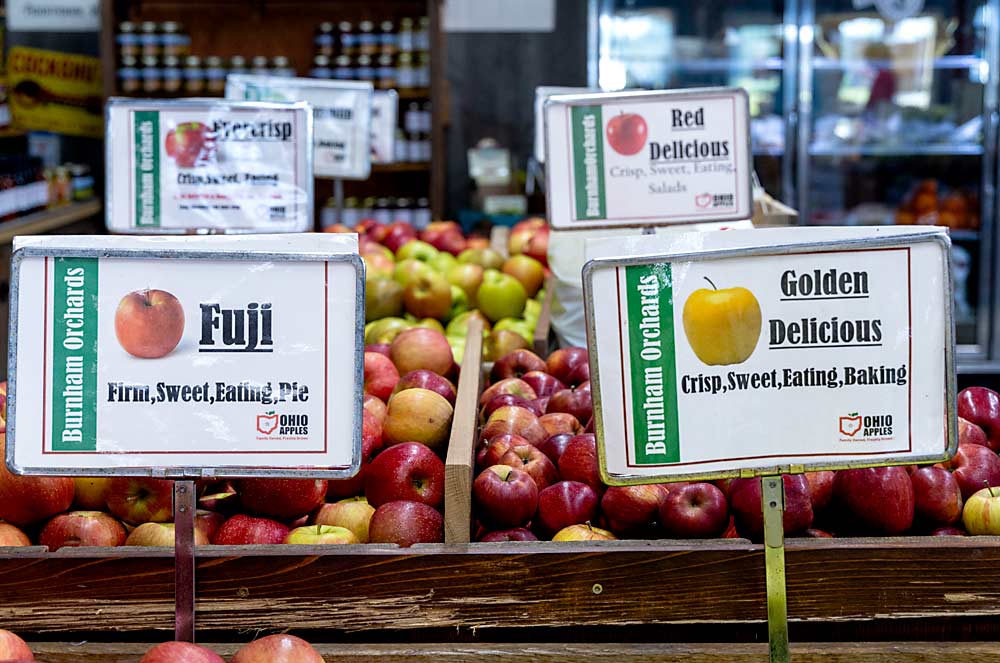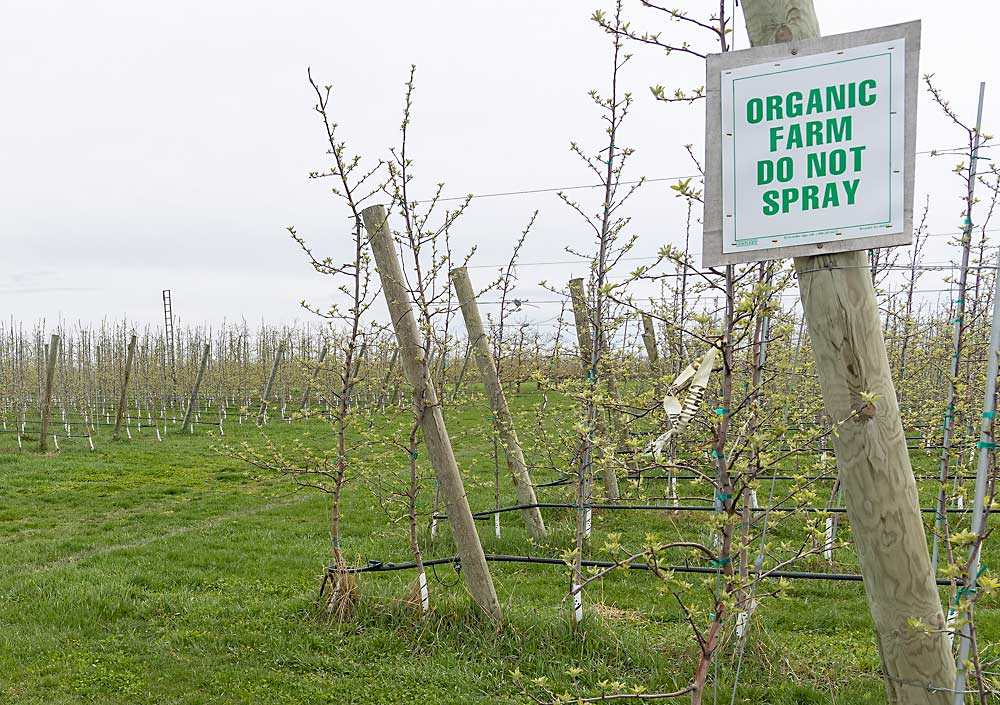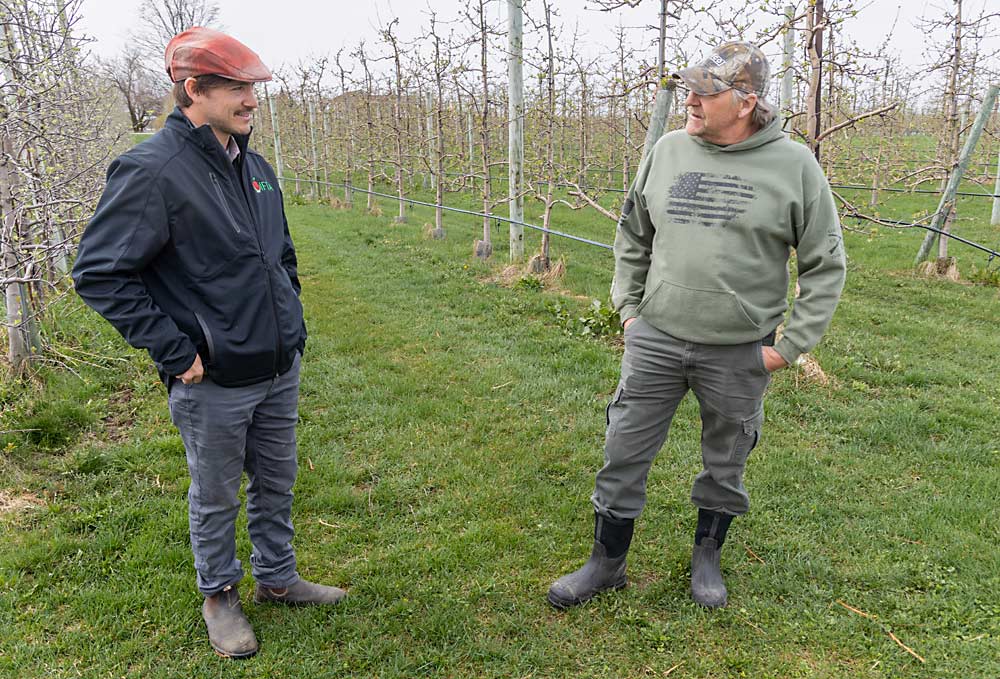—by Matt Milkovich

Low business apple costs have compelled many Midwestern growers to pivot in numerous instructions to seek out extra worthwhile gross sales avenues for his or her fruit. Some growers are turning towards licensed natural markets, others towards direct-retail gross sales. Good Fruit Grower reached out to a couple growers to study what they’re doing in response to troublesome wholesale market dynamics.
Natural
Michigan grower Kyle Rasch and his father, Tom Rasch, at Third Leaf Farm, determined in summer time 2023 to transition their remaining standard apple acres to licensed natural. They’d been transitioning 10 or 15 acres per yr for a number of years, however “abysmal” standard costs pushed them to transition the remaining 70 acres unexpectedly, Kyle Rasch mentioned. Their apples will all be able to promote within the natural market by 2026.
The total transition simplifies horticultural administration, too. Their blocks at the moment are underneath a single administration system, quite than being cut up between standard and natural, he mentioned.
“There’s not a lot hope left on the standard aspect,” Rasch mentioned. “Natural is a rising market, and we’ve seen sufficient alternatives to be excited. That is the primary season we’ve had sufficient fruit for the market we’re already promoting for.”

Rasch is aware of of greater than a half-dozen different Michigan growers — all sensing the chance for larger costs with contemporary and processing apples — who’re transitioning at the very least a few of their acres to natural. Some processors are already shopping for licensed natural apples, whereas others are ready for extra quantity to change into accessible, he mentioned.
“There’s all the time some share of fruit that doesn’t make the grade,” Rasch mentioned. “We have to create extra alternatives for second-quality processed natural fruit in Michigan.”
Despite the fact that Third Leaf Farm is “far off the overwhelmed path,” he mentioned, it’s been direct-marketing natural apples for the previous six years. In the meantime, the small on-farm market and handful of U-pick blocks permit native customers to mix an on-farm expertise with shopping for natural produce.
“We haven’t constructed up a carnival, only a place to cease and get natural apples,” Rasch mentioned. “A busy weekend for us is 50 clients.”
Farther west at Joe Rasch Orchards, grower Manuel Vargas determined to transition 20 acres to natural in 2023. He’s hoping the apples will fetch larger costs after they enter the natural market in 2026. Vargas mentioned standard processing apples are incomes about 6 cents per pound proper now, whereas natural processing apples are incomes as much as 35 cents per pound.
The bushes they’re transitioning — Fuji, Gala, Jonastar and MAIA-1 (marketed as EverCrisp) — signify about 5 % of their whole acreage. Natural bushes require extra intensive administration and a better dedication of labor, however Vargas hopes the additional work will herald additional earnings.
“We’re simply looking for one other market, and hopefully make some cash,” he mentioned. “It’s arduous to promote apples proper now.”

Direct retail
Illinois farm market Eckert’s not too long ago determined to take away about 30 acres of older, semidwarf bushes — practically 1 / 4 of its whole apple acreage — to focus extra on direct retail and get out of the wholesale apple market altogether, mentioned President Chris Eckert.
“Wholesale simply doesn’t pay,” he mentioned. “We are going to deal with retaining new varieties for pick-your-own and in-store retail gross sales.”
They’re pulling out older varieties like Pink Scrumptious, Golden Scrumptious and Jonathan that not have a wholesale market. He mentioned wholesale costs are down greater than 25 % from three years in the past, after rising briefly through the coronavirus pandemic.
In the meantime, their labor prices have gone up about 45 % since 2019.
This isn’t the primary time Eckert’s has pivoted away from wholesale apples.
“We bought out of the wholesale apple market within the early ’90s,” Eckert mentioned. “Then we crept again in due to oversupply for pick-your-own.”
It’s simpler to regulate pricing, and subsequently keep profitability, in direct retail, he mentioned, whereas in wholesale it’s a unique story. “I really feel like I’m shedding cash on each bushel I decide,” Eckert mentioned.
Candy and arduous cider are different good shops for extra apple manufacturing, however U-pick is “by far essentially the most worthwhile solution to promote apples,” Eckert mentioned.
Ohio grower and farm marketer Joe Burnham mentioned he additionally goals to promote extra apples via farm market and U-pick channels, however there are solely so many apples a grower can promote that method. He’s additionally hoping wholesale costs will rise once more quickly.
At Inexperienced’s Fruit Farm in Pennsylvania, Bobby and Sara Hricko began shifting to direct market gross sales not lengthy after inheriting the household farm from Bobby’s grandfather. Once they took over in 2018, most of their 65 acres of apples had been offered to a packing home. Now, about half go to the packing home, and the opposite half are offered instantly via their farm market and U-pick blocks.
The farm earns about as a lot income because it did 10 years in the past, however contemplating the dangerous climate and low costs in that interval, holding regular isn’t essentially a foul factor, they mentioned.
“Direct advertising and marketing is a ton of labor, however it’s helped to make our enterprise extra resilient,” Bobby mentioned. “We’re in a position to pivot extra shortly and react to challenges.” •



